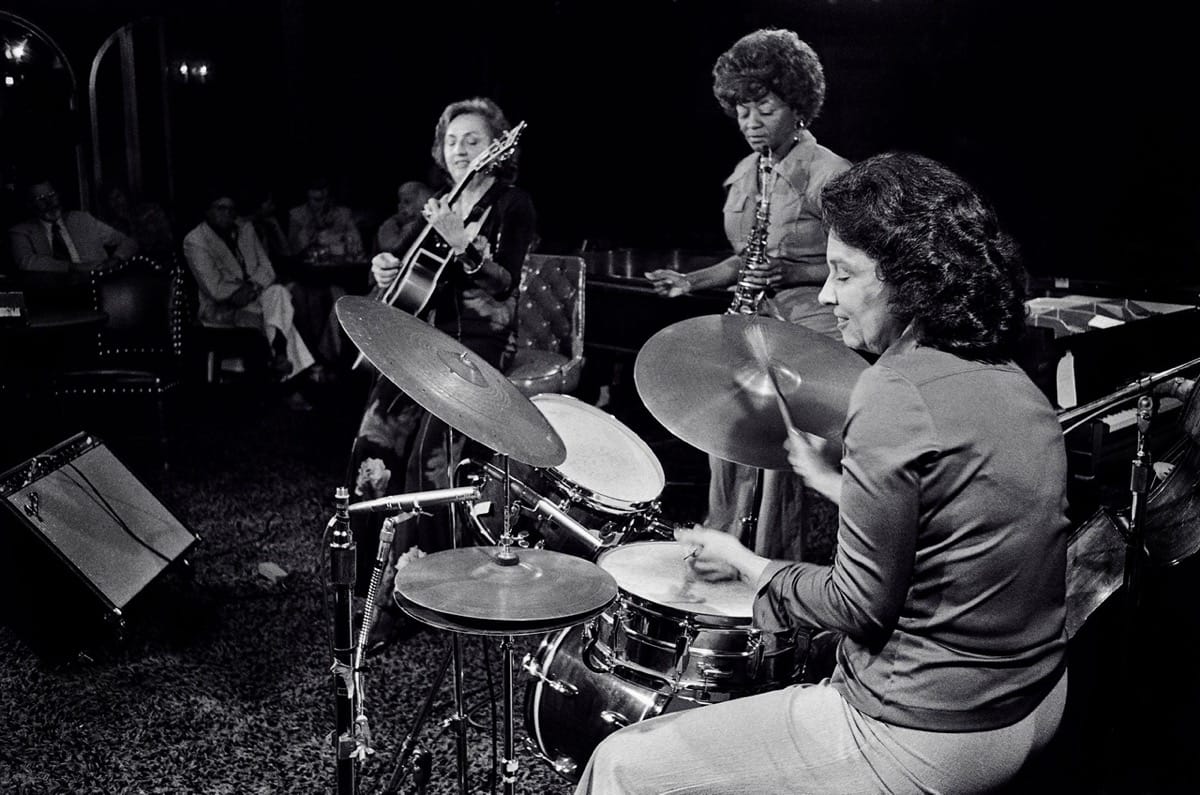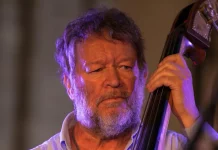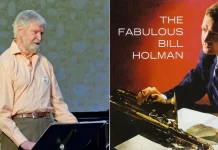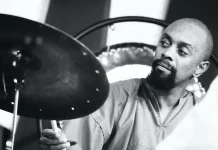Drummer and vocalist Dottie Dodgion died (after a stroke) at the age of 91 on 17 September in a hospice in Pacifica Grove, California. Still musically active until a year before her death, she played on Thursday nights at a club in Pebble Beach, Monterey. Because of sciatica, she usually sat behind her drums on a modified bicycle seat, covered with a pillow.
Her passing has seen an outpouring of grief and commendation from her fellow musicians and friends. Yet she is not generally known to the jazz public – partly because of her slim discography with only one recording as leader – Dottie Dodgion Sings (Arbors Jazz, 1993), as accompanist on The Music Of Ruby Braff And His International Jazz Quartet (Chiaroscuro, (1972), and Now’s The Time, with Marian McPartland (Halcyon, 1977).
Fortunately, she can also be seen and heard on several YouTube clips, and has been profiled by Sally Placksin, American Women In Jazz: 1900 To The Present (1982), and Linda Dahl, Stormy Weather: The Music And Lives Of A Century Of Jazz Women (1984). Even more rewardingly, Dodgion (with Wayne Enstice) published her autobiography The Lady Swings: Memoirs Of A Jazz Drummer during lockdown in March of this year.
Admired for her unobtrusive but considered and delicate approach to jazz drumming, she advised: “Don’t let ego get in the way. Think about the whole sound more than one’s self. You’re never going to swing if you’re the only one who thinks they have the correct time.”
Despite the prejudice of male musicians and the misogyny of record producers and club owners, Dodgion from the outset of her long career kept distinguished company. She worked with Benny Goodman, Zoot Sims, Wild Bill Davison, Joe Venuti, Marian McPartland, Ruby Braff, Tony Bennett and Melba Liston. Goodman hired her in 1961, but she received her marching orders after she attracted louder audience applause than her employer.
Critic Dan Morgenstern heard Dodgion as a member of a Phil Woods quartet at a Jazz Interactions Sunday Top of the Gate session in New York in 1967. He commended the “excellent support” Woods received from pianist Hal Galper, bassist Richard Davis and drummer Dodgion. He also recalled that “female drummers being something of a novelty, a number of customers registered initial surprise at seeing an attractive woman behind the drums” but quickly added that her playing “needed no visual aid”. And although it was “supposedly a compliment to say a female musician plays like a man, Mrs. Dodgion certainly had a swinging drive and confidence comparable to a male drummer, but her playing also had an intuitive quality that seemed distinctly feminine”. He added: “With commendable modesty, she restricted her solo excursions to some good four-bar exchanges, taking only one long solo all night.”
She was born Dorothy Rosalie Giaimo in Brea, California on 23 September 1929. Her father Charles was a drummer and her mother Ada Tipton a waitress with ambitions as a dancer. Charles deserted the family when Dottie was two years old. When she was five and living at her grandparents’ house in Los Angeles, he “kidnapped” her (Dottie’s phrase), and she spent the next two mainly enjoyable years with him on the road as he played strip clubs and road houses with a small group. When she was seven, she returned to her mother, who had remarried. She was raped by her step-father when she was 10 (he was sentenced to 20 years in prison), and moved (with her mother) to Berkeley, from where she made bus trips to San Francisco to see her father perform at a strip club. She later wrote that “his excellent time attracted all the best strippers”.
Other influences on her development as a drummer included bassist Eugene Wright who, she explained, “coached me on the nuances of playing in a rhythm section” and her subsequent marriages to another bassist Monty Budwig and saxophonist Jerry Dodgion. Budwig was not in favour of his wife playing a “male” instrument, but Dodgion had no such reservations. In her memoir, Dottie writes: “What he taught me encompassed everything I ever thought I would want to do in music.”
Another bassist, Eddie Gomez, who played in a trio with Dodgion in 1964, told Megan Mayhew Bergman: “Dottie’s smile epitomized her – the way she played, the way she felt about life. She was dedicated to the swing and the good feeling of the music.” Her favourite (male) drummers were Kenny Clarke, Kenny Clare and “Tootie” Heath. Linda Dahl’s first-hand description of Dodgion’s playing and persona, at a “tavern” in New Jersey in 1973 is entirely convincing: “Her physical approach to the drums is lithe, graceful, easeful. Playing gives a constant, curving smile to her face as, like a painter she wields her brushes over her palette of drums and cymbals or punctuates, light-wristed, with the sticks. Head tilted, she listens, and her rhythm swings.”
The indomitable Dodgion should have the last words – taken from her autobiography: “I persevered through gender prejudice that typecast me according to my looks and laid roadblocks in my path to becoming a professional jazz musician. Those roadblocks came in two flavours: blatant sexist behaviour, or the more subtle ploy of invoking chauvinistic cultural values that defined what and what was not dignified work for a woman.”
Photo, left to right: Mary Osborne, Vi Red and Dottie Dodgion, c. 1977, by Tom Marcello
















